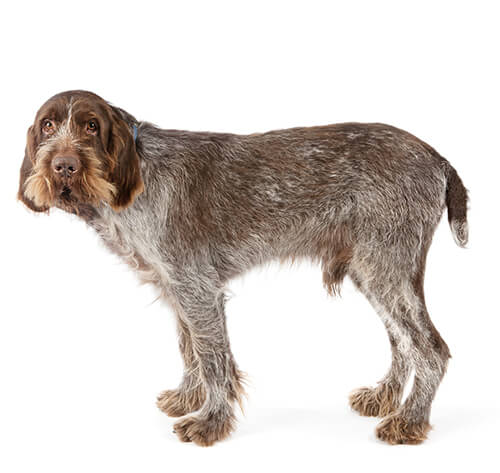
Large, shaggy and friendly, the Italian Spinone is a solid and robust member of the Gundog group. They come in a white coat of medium length, that’s coarse and dense. The Spinone has an attractive, characterful face with expressive eyebrows and a dense beard and moustache.
The need-to-know
- Dog suitable for owners with some experience
- Some training requiredEnjoys vigorous walks
- Enjoys walking more than two hours a day
- Large dog
- Some drool
- Requires grooming every other day
- Non hypoallergenic breed
- Quiet dog
- Not a guard dog
- May require training to live with other pets
- Great family dog
Personality

Work hard – play hard is the Spinone’s ethic. As happy in water as they are on land and capable of working all day, yet playful and friendly at home, it is easy to see why this breed is still popular as a working dog, and as a companion. As with all larger dog breeds, particularly those of a slower, gentler nature, the Spinone is a slow maturing breed, but very much worth the wait! As puppies they are endlessly endearing and comical, and adults become somewhat more dignified but still retain a humorous and affable nature.
History and Origins

Country of Origin: Italy
The Spinone’s origins are uncertain, with possible influences from early French hounds such as Barbets and Griffons, or possibly descending from older Italian hounds such as the Segugio Italiano. Whatever the truth, dogs resembling Spinones can be seen in paintings from the Renaissance period, and they have a long working history in the hunting field as a Hunt, Point, Retrieve (multi-function) breed.
Nutrition and Feeding

Large dog breeds have large appetites and benefit from a different balance of nutrients including minerals and vitamins compared to smaller-breed dogs. The Spinone is also prone to bloating and stomach problems. Smaller, more frequent meals can help minimise this risk. Discover more about how to offer your dog a balanced diet with our easy-to-follow guide.
Exercise

Two hours of dog exercise a day is the minimum for this canine and that should be a mixture of walking, running, and playing as well as training. They will enjoy long country walks and retrieving from land or water, and won’t be put off by rough terrain or thick cover. Prepare to get wet and muddy with a Spinone!
Other Information

Health and Common Issues
The Italian Spinone is generally a healthy, robust breed. As with many large breeds, they can suffer from hip dysplasia (a condition that can lead to mobility problems). Hip scoring of dogs prior to breeding is therefore important.
Space Requirements
The Italian Spinone is a big dog, with a big coat that holds a considerable amount of water, mud and countryside, and can produce a lot of drool after a big drink. A larger home and big secure garden, with easy access to a variety of country walks are important - as is a large vehicle. The Spinone is not suited to living in smaller homes or multi-storeys with many flights of stairs, nor ideal for the city.
Training Italian Spinone
Not one of life’s problem solvers, the Spinone will prefer training ‘as you go’ rather than training as a hobby in its own right! They do have a sense of humour however, and a bored Spinone, or one who doesn’t see the point of what you are asking of them, will quickly demonstrate their clownish streak. If you are patient, take the time, and are rewarding to work with, a Spinone will enjoy working with you.
Best Family Dog Breeds
For the active family, happy in the great outdoors through all sorts of weather, the Spinone is an excellent companion. With smaller children however this gundogs desire to carry toys can cause issues and their size is such that they may easily knock over the small or frailer members of the family. While many dogs are traditionally thought of as being good with children, all dogs and children need to be taught to get on with each other and be safe together. Even so, dogs and young children should never be left alone together and adults should supervise all interactions between them.
Did You Know?
Their name is derived from an older name for the breed, ‘Bracco Spinoso’ and refers both to the wiry, prickly texture of the coat and also the prickly undergrowth they would hunt game through.